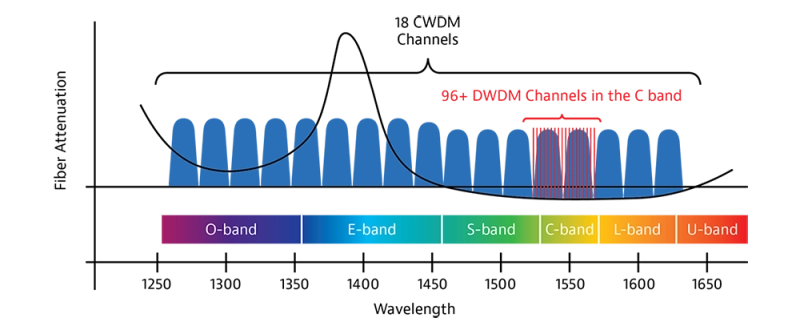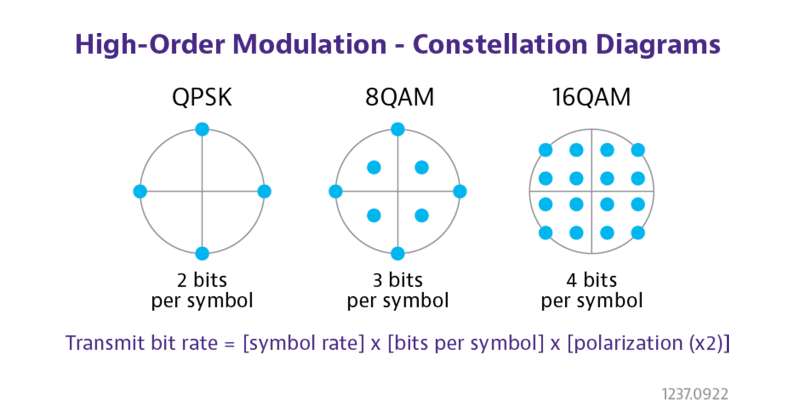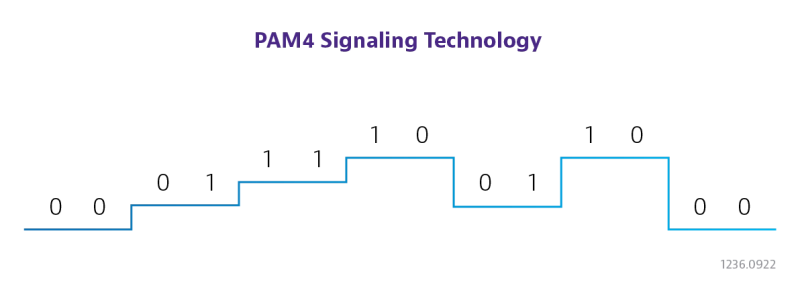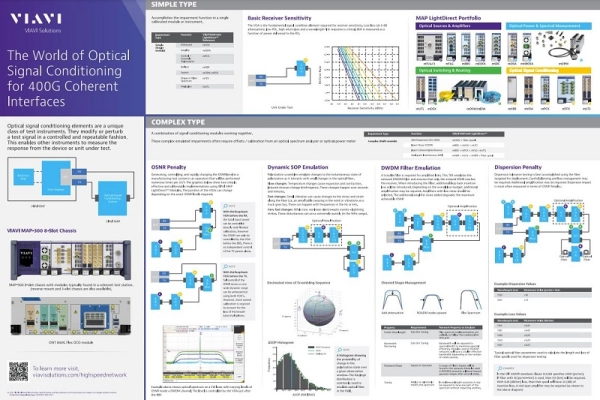What are Coherent Optics?
Learn about coherent optics, the associated applications, and how they help deliver more data over the same fiber format.
Coherent optics are typically used for ultra-high bandwidth applications ranging anywhere from 100 Gigabit to 1 Terabit per second. Powerful digital signal processing chips (DSPs) are embedded within these systems to mitigate non-linear effects caused by fiber impairments, including chromatic dispersion and polarization mode dispersion.
Coherent fiber optics utilize the natural properties of light to optimize digital modulation practices and fiber optic carrying capacity in long-range applications. VIAVI has developed versatile, industry-leading solutions to support the unique design validation, compliance testing, and manufacturing requirements of coherent optical modules.
Download Poster: The World of Optical Signal Conditioning for 400G Coherent Interfaces
With the release of the IEEE 802.3ct standard, coherent optics can now be used to carry 400G over extremely long distances. Light intensity modes of modulation have given way to a comprehensive approach requiring advanced digital signal processing technology, forward error correction (FEC), and tunable lasers.
- Coherent Optics increase fiber transmission capacity by 80X as compared to conventional on-off keying (OOK) methods, keeping pace with 400G and 800G Ethernet commonly used for cloud and hyperscale data center interconnects.
- Homodyne receiver technology is among the enabling fundamentals of coherent optical fiber communications. The sensitivity and selective tuning afforded by this technology allows for the requisite tight spacing of optical channels.
- Forward Error Correction (FEC) is an additional fundamental attribute which enables higher bit-rate signals to traverse longer distances, with less in-line regenerators. Reduced link complexity and equipment outlay minimize cost while improving bandwidth.
- Coherent Optical Modules used in high-bandwidth applications include an optical interface connected to outgoing fiber links and an electrical interface for system connection. Advanced form factors including CFP2 and QSFP-DD continue to improve as the standards evolve.
What is a Coherent Optical Fiber Communication System?
A coherent optical fiber communication system leverages variable properties of light waves, including amplitude, phase, and polarization, to optimize the capacity of a fiber optic link. Far exceeding the limitations of traditional OOK, coherent optical transmission deploys tunable lasers and sophisticated digital signal processing at both ends the line to effectively modulate and demodulate each of these properties.
As a fully digital transmission method, coherent fiber optics are customizable to suit a variety of applications and line rates. The high spectral efficiency (e.g., number of bits that can be transferred in the optical spectrum) and reduced amplification requirements are ideal for high-bandwidth dense wave division multiplexing (DWDM) applications. Important coherent optics fundamentals and applications include:
- Coherent Modulation: Transmitters used for coherent optics applications expand upon OOK methods used to designate a “1” or “0” based on light intensity alone. By selectively modulating the amplitude, phase, and polarization of the light wave, an exponentially higher volume of data can be encoded within the same physical space and time.
- Coherent Demodulation: At the receiver end of the link, coherent demodulation is performed to decode the transmitted data into an electrical format. This is typically completed using optical heterodyne architecture which includes a photodetector, local oscillator, and sequential (bandpass and low-pass) optical filters.
- Data Center Interconnects: DCIs continue to deploy the latest transmission technology to meet the ever-increasing bandwidth and distance requirements of hyperscale data centers. Standards bodies including the Optical Internetworking Forum (OIF) are striving to improve the interoperability of DCI and metro Ethernet coherent optics.
- Submarine Cables: With 99% of global data traffic flowing through undersea links, the high-capacity, long range, and reliability gained through coherent optical technology is a logical fit. Coherent optics reduce the initial cost and power consumption of submarine networks while improving their security and signal integrity.
Wavelength Division Multiplexing (WDM) enables multiple colors (wavelengths) of light to travel over the same fiber simultaneously, with each color carrying a discrete signal. This concept has been taken to the next level through dense wavelength division multiplexing (DWDM), with tighter wavelength spacing accommodating up to 96 channels on a single fiber. When combined with coherent modulation, individual channel bandwidth can expand to 400 or 800 Gigabits
- DWDM is the only transmission technology that can support both coherent optics and OOK.
- When coherent optics are deployed in DWDM systems, channel width may need to be adapted based on the spectral width. Flexible grid architecture and dynamic channel spacing allow each channel to have a different passband.
- Coherent optical fiber communication eliminates the need for dispersion compensation modules (DCMs) in DWDM systems, since this function is completed by the DSP.

How Coherent Optics Deliver More Data
Delivering more data over the same fiber format has been the goal of scientists and engineers for decades. With bandwidth requirements continuing to challenge hardware capacity, innovation in this space has gone from nicety to necessity. Since on-off modulation is limited to 10 Gigabit/sec. transmission rates, coherent optical technology is essential for maximizing data capacity.
- Coherent Optics enable more symbols per bit to be encoded. While traditional amplitude modulation is limited to 1 bit per symbol, 4, 8, 16, or 32-bits per symbol are possible using coherent methods.
- Small Form Factor Coherent Pluggables such as QSFP-DD modules provide 8 data paths, each with 56 Gb/sec. of throughput. This produces a combined 400G capacity per transceiver.
- Advanced Modulation Formats leverage the adaptable properties of light (amplitude, phase, and polarization) to optimize carrying capacity. Three degrees of freedom combined with precise digital tuning create exponentially more encoding combinations.
Coherent Optics Definitions
- What is Amplitude Modulation?
As the name suggests, amplitude modulation is a method used to encode data based on the amplitude (intensity) of light. While OOK modulation employs amplitude modulation in a binary (on-off) fashion, coherent optics utilize amplitude shift keying (ASK) to increase the available symbols. - What is Phase Modulation?
The frequency of light at a given wavelength is highly predictable in an unmodified state. Modulating the phase creates a change in this pattern that is decoded by the demodulator at the receive end. For coherent optics, this process is known as phase shift keying (PSK). - What is Polarization?
As a form of electromagnetic energy, polarized light waves produce an electric field which oscillates perpendicular to the direction of travel. The horizontal and/or vertical orientation of this electric field can be induced to provide an additional vehicle for data encoding. - What is QPSK?
Quadrature Phase Shift Keying (QPSK) is a phase modulation technique which allows multiple symbols per bit to be encoded based on four phase shift orientations (e.g., 0°, 90°, 180°, and 270°). Dual Polarization Quadrature Phase Shift Keying (DP QPSK) uses horizontal and vertical polarization along with QPSK to represent twice as many bits.

Pulse amplitude modulation (PAM4) is a multi-level modulation scheme designed for short-haul fiber links. PAM4 utilizes four amplitude pulses, each containing two bits, to double the bandwidth of conventional binary methods. The simplicity and low power requirements of PAM4 make it a popular option for 100G and 400G Ethernet applications.
Unlike coherent optics, PAM4 is highly susceptible to fiber impairments. This limits range to ≤30 kilometers for unamplified links. PAM4 is often used for client interfaces as defined by the IEEE, whereas coherent optical fiber communication systems, as specified by the OIF or ITU, can potentially span thousands of kilometers on unamplified links.

- PAM4 is more susceptible to noise as compared to coherent optics. To compensate, a higher signal-to-noise (SNR) ratio must be established.
- PAM4 technology can be deployed with existing DWDM systems, although additional inline multiplexing and dispersion compensation are required for links of over six kilometers.
- QSFP28 transceiver modules utilizing PAM4 modulation support 100 Gigabit transmission speeds and are suitable for many short-range applications.
- While built-in DSP chips improve sensitivity and amplification performance for coherent optics, they also result in higher power consumption and ongoing operating costs.
